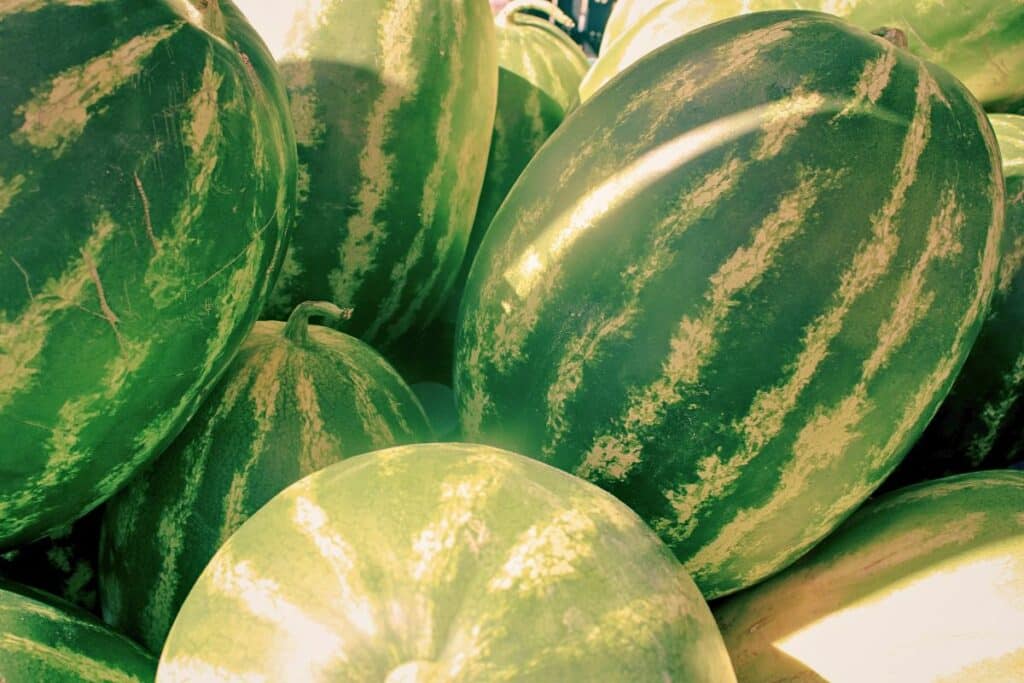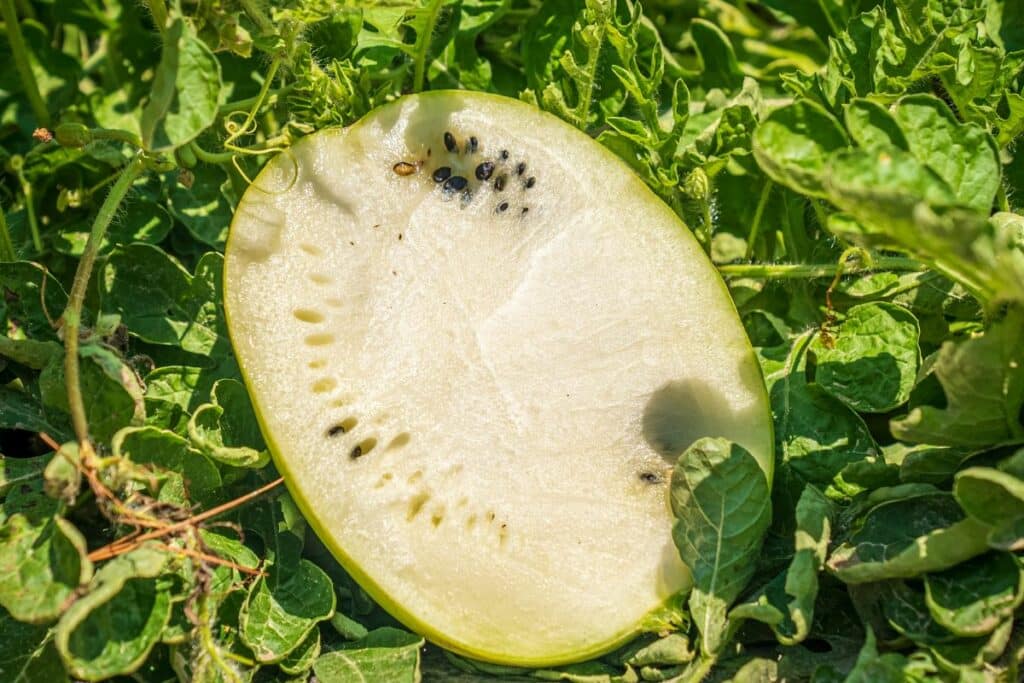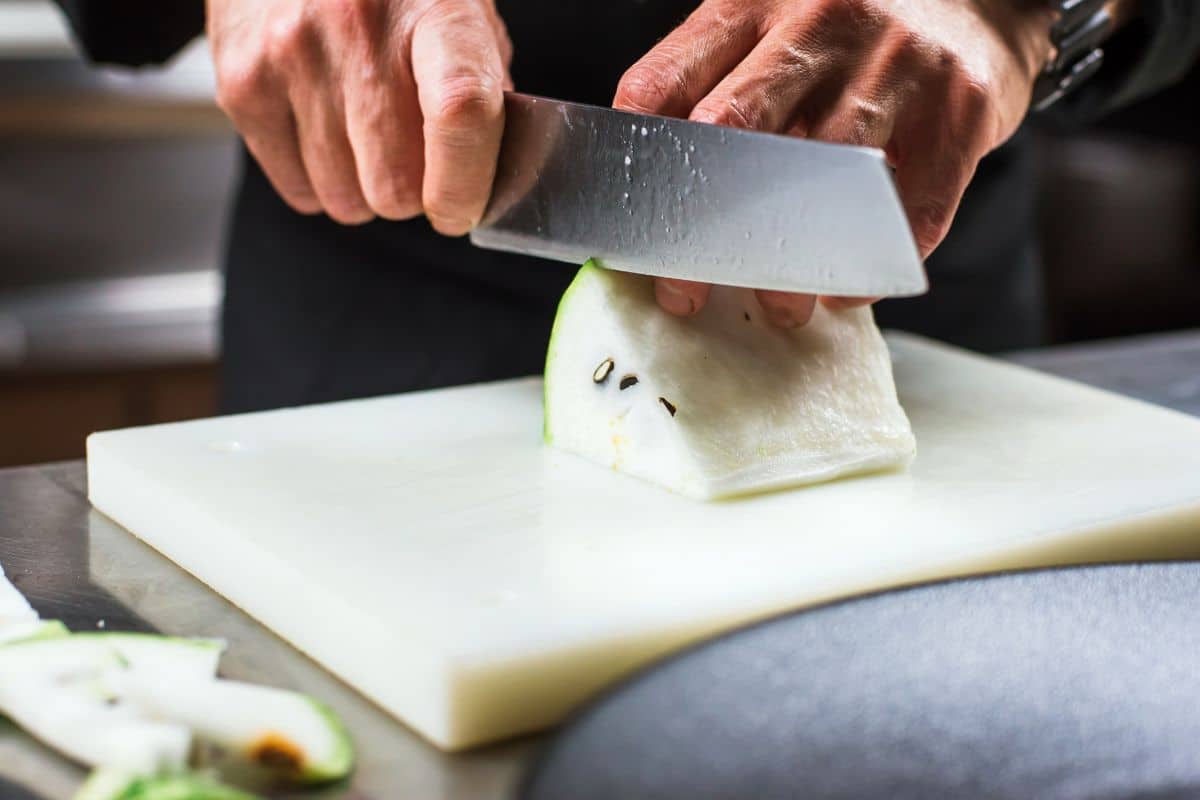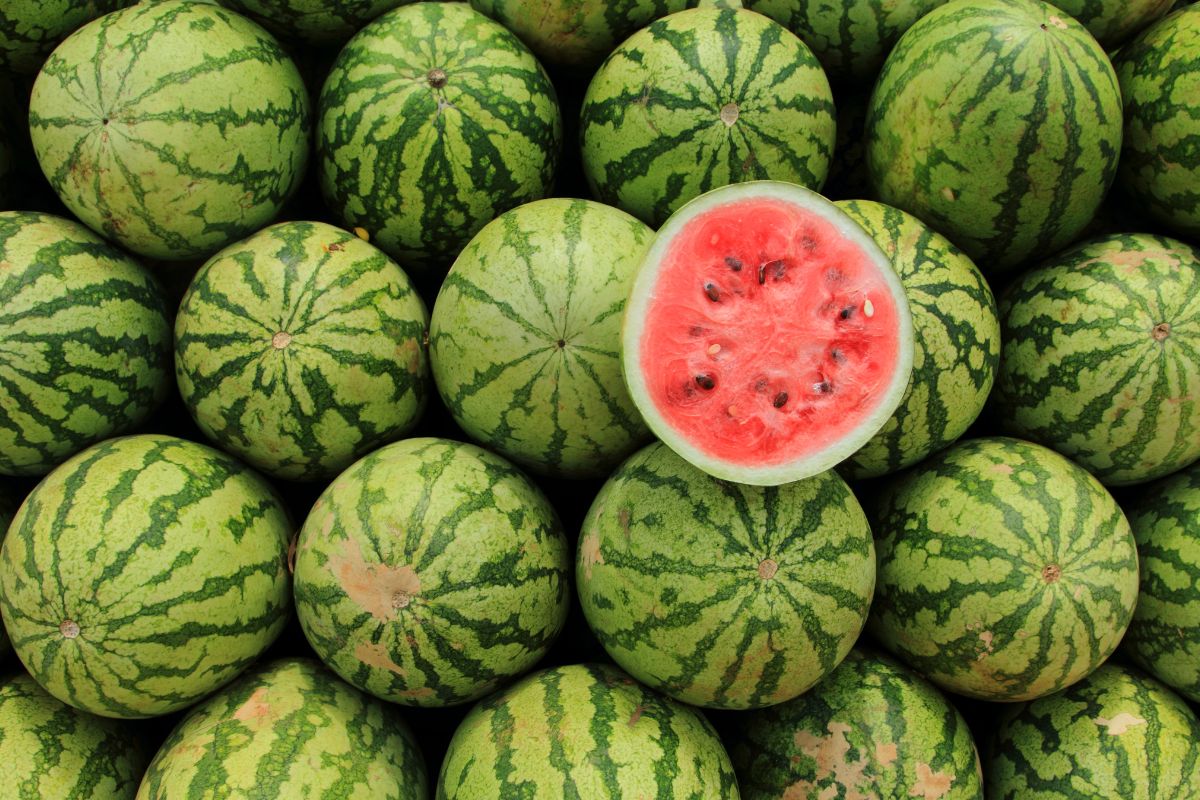When we think of a watermelon, then we usually imagine the classic dark green skin with a juicy pink flesh. But there are a number of reasons why your watermelon may be yellow or white.
If you have a watermelon with white flesh you may wonder if you can safely eat white watermelon?

Most white watermelons are safe to enjoy but they might not taste as nice as yellow or pink watermelons.
In this guide, we explain everything you need to know about white watermelons, where they come from, what makes their flesh white and if you can safely eat them.
Let’s start off with why your watermelon has white flesh on the inside.
Why Is Your Watermelon White Inside?
Although we often imagine a tasty watermelon to be pink on the inside, there are a number of reasons why your watermelon is white.
Your Watermelon Isn’t Ripe Yet
The most common reason why a watermelon is still white inside is that it is not ripe yet. If the fruit hasn’t reached its full ripening stage yet, then it may have a white flesh.
If a watermelon didn’t get the right ripening conditions or it was picked before it fully matured, then you will notice that the flesh is either partially or fully white.
The coloration in a watermelon comes from an essential nutrient called lycopene.
When a watermelon is harvested too early, then the fruit doesn’t have enough time to produce lycopene to develop its color on the inside.
Watermelon fruit takes between 65 and 120 days to mature fully. They are usually already ripe between 70 and 90 days.
It can happen that watermelons are picked too early due to the varying ripening processes, which means that you may end up with a white watermelon.
Naturally White Watermelon

Another potential reason why your watermelon is white inside is because it is simply a white variety of watermelon.
There are a number of different watermelons that produce white or cream-colored flesh, such as Saskatchewan watermelon or white honeydew melon.
These small melons also often have a light yellow or white color skin on the outside.
White Heart
White heart is a common disease that attacks the flesh of the watermelon because of too much moisture during the maturation stage.
It can discolor the outer and inner sides of the watermelon.
Typically, a watermelon that is affected by white heart has white streaks in the center of the fruit. You may also notice that the fruit is less juicy or cracked on the inside.
Is It Safe To Eat White Watermelon Flesh?
This depends on the type of watermelon you have. If you have a melon that is naturally white, then you can safely eat it without any problems.
If you have an unripe watermelon that should have a different color of flesh, then it is best to wait for a few more days until it has fully ripened.
While the unripe flesh won’t cause any harm, it doesn’t taste as nice as a fully ripened fruit.
If you believe that your watermelon is affected by white heart disease, then it is also perfectly fine to eat.
The white heart only affects the appearance of the melon’s flesh but not the taste.
Can You Eat Unripened Watermelons With White Flesh?

Yes, you can safely enjoy unripened watermelons that have a white flesh. This being said, they don’t taste as juicy and sweet as you would expect from ripe fruit.
Unripe watermelons haven’t had a chance yet to produce sugar which means that your fruit would taste watery and bland. While these melons are safe to consume, you would compromise on taste.
What Watermelons Are Naturally White Inside?
There are plenty of watermelons that are naturally white varieties, including white honeydew melons, cream of Saskatchewan watermelon and the white sugar lump watermelon.
These types of melon varieties won’t ever turn red regardless of how long you ripen them. Instead, their inside flesh always stays cream or white.
It is a good idea to check if you have purchased one of these melon varieties because they can taste slightly different from yellow or pink watermelons.
Plus, hard white watermelons are typically more suitable for baking and pickling rather than your classic fruit salad ones.
How To Avoid White Flesh In Your Own Watermelons
If you don’t like the white flesh of watermelons, then it is best to avoid white watermelon varieties.
If you are growing watermelons yourself and you want to avoid the white flesh, then make sure that you offer your plants the right growing conditions to prevent white heart.
White heart develops during the final growing stages of the fruit.
If you water your plant too much or moisture levels are too high during this time, then the fruit may have white streaks.
It is also important to provide the right amount of feed to your watermelons, so they can produce the essential nutrients that turn the white flesh into a pink or yellow color.
How To Choose A Ripe Watermelon

Unless you prefer a white watermelon variety, it is a good idea to check that your melon is ripe before you eat it.
This doesn’t just mean that you can avoid white watermelons but you can also ensure that your watermelon tastes pleasant.
Here are a few methods to test your watermelon and find out if it is ripe enough to enjoy.
Check The Outside Of The Watermelon
While a scratch or small dent often doesn’t affect the taste of a watermelon, you can spot the ripeness stage of the fruit when you check the tops.
If the ends of your watermelon are blunt, then the fruit is likely ripe. On the other hand, if the tops on both sides appear pointy, then you have an unripe fruit.
Do The Press Test
Another way to make sure that you pick a ripe watermelon is to do a gentle press test. Find the spot opposite the stem and lightly press it.
If it gives way, then your fruit is ripe but if it feels like you are pressing a hard surface, then it isn’t ready yet.
Perform A Scratch Test
In order to find out if your watermelon is fully ripe, you can also do a scratch test.
Simply scratch the rind anywhere on your melon. If the fruit reveals some of the white layer underneath, then it is ripe.
It will also be more difficult to scratch an unripe melon which results in just a dark line.
Check The Pulp
If you aren’t sure whether you have an unripe watermelon or a naturally white variety, then you can also check other signs of ripeness.
Loose pulp in the center of the watermelon is typically a sign that your melon is overripe. These melons typically taste dry and flat, so it is best to dispose of them.
On the other hand, if you have a watermelon that has a firm flesh with all the pulp in place, then you may have a ripe fruit.
Check The Weight
A good watermelon should be a standard size between 6 to 10kg. However, this strongly depends on the watermelon variety.
If you know the variety and your fruit is too light, then your fruit is likely not ripe yet.
Final Thoughts
Watermelons are super delicious. You can enjoy them raw, in a fruit salad or even mixed in with your smoothies.
There are many different reasons why your watermelon is white, from the distinctive white melon varieties to early harvesting of unripe fruit.
If you have an unripe watermelon, then it is a good idea to let it ripe for a little longer to make sure that you get the full juiciness and sweetness from your favorite fruit.






